NEW MOON: LAUNCHING ALPHA
Terra, mother of all humanity,
has proven very fertile and will give some of her children a promising send off.
Terra's little sister, Luna,
is eager to help with her ample resources. |
|---|
| LUNAR MINERALS |
|---|
 Routine mining operations can uncover useful materials from Moon. Large areas of Lunar surface are covered with regolith to a depth of several meters. This substance is largely composed of materials shown in following chart. Elements on the lunar surface include: oxygen (O), silicon (Si), iron (Fe), magnesium (Mg), calcium (Ca), aluminium (Al), manganese (Mn) and titanium (Ti). Among the more abundant are oxygen, iron and silicon. The oxygen content is estimated at 45% (by weight). Carbon (C) and nitrogen (N) appear to be present only in trace quantities from deposition by solar wind. Neutron spectrometry data from Lunar Prospector indicate the presence of hydrogen (H) concentrated at the Lunar poles.
Routine mining operations can uncover useful materials from Moon. Large areas of Lunar surface are covered with regolith to a depth of several meters. This substance is largely composed of materials shown in following chart. Elements on the lunar surface include: oxygen (O), silicon (Si), iron (Fe), magnesium (Mg), calcium (Ca), aluminium (Al), manganese (Mn) and titanium (Ti). Among the more abundant are oxygen, iron and silicon. The oxygen content is estimated at 45% (by weight). Carbon (C) and nitrogen (N) appear to be present only in trace quantities from deposition by solar wind. Neutron spectrometry data from Lunar Prospector indicate the presence of hydrogen (H) concentrated at the Lunar poles. LUNAR RESOURCES
Oxygen from the Moon. 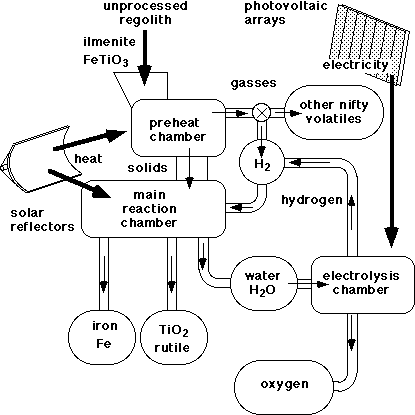 Oxygen is necessary for breathing, and it has several other uses (for example: rocket fuel). Fortunately, oxygen is the most abundant element in lunar soil. Lunar oxygen can be processed into liquid and stored in tanks made from lunar metals; then, it can be easily launched from the Moon with escape velocity of only 2.4 kilometers per second (kps), much less than Earth's escape velocity of about 11.2 kps.
Oxygen is necessary for breathing, and it has several other uses (for example: rocket fuel). Fortunately, oxygen is the most abundant element in lunar soil. Lunar oxygen can be processed into liquid and stored in tanks made from lunar metals; then, it can be easily launched from the Moon with escape velocity of only 2.4 kilometers per second (kps), much less than Earth's escape velocity of about 11.2 kps.
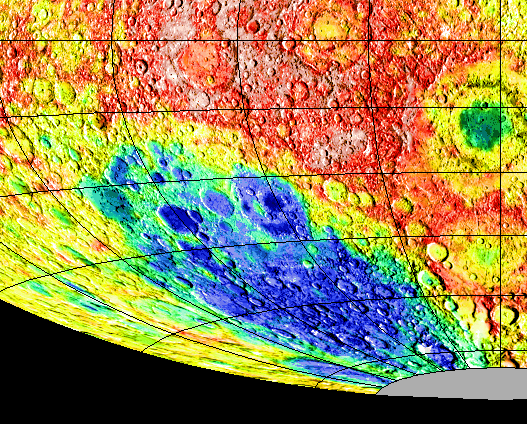 Ice on the Moon Data from the Lunar Prospector spacecraft indicates water ice at both the north and south lunar poles.
Ice on the Moon Data from the Lunar Prospector spacecraft indicates water ice at both the north and south lunar poles.
This agrees with previous results from the Clementine mission.
Scientists estimate as much as 6 trillion kilograms of lunar ice.
Helium-3.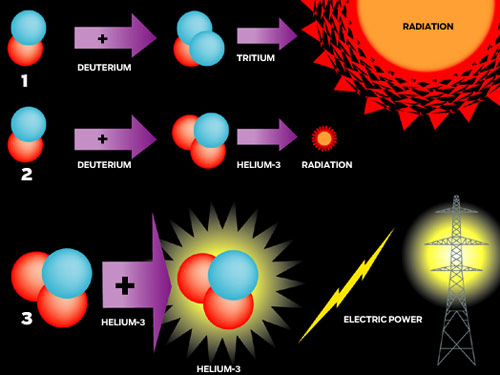 Researchers and space enthusiasts see helium 3 as the perfect fuel: extremely potent, nonpolluting, with virtually no radioactive by-product. While rare on Earth, it's much more plentiful on Luna.
Researchers and space enthusiasts see helium 3 as the perfect fuel: extremely potent, nonpolluting, with virtually no radioactive by-product. While rare on Earth, it's much more plentiful on Luna.
Some habitat components might be best manufactured on the Moon; then, launched for immediate use on the habitats. A few examples include:
Mirrors for Light.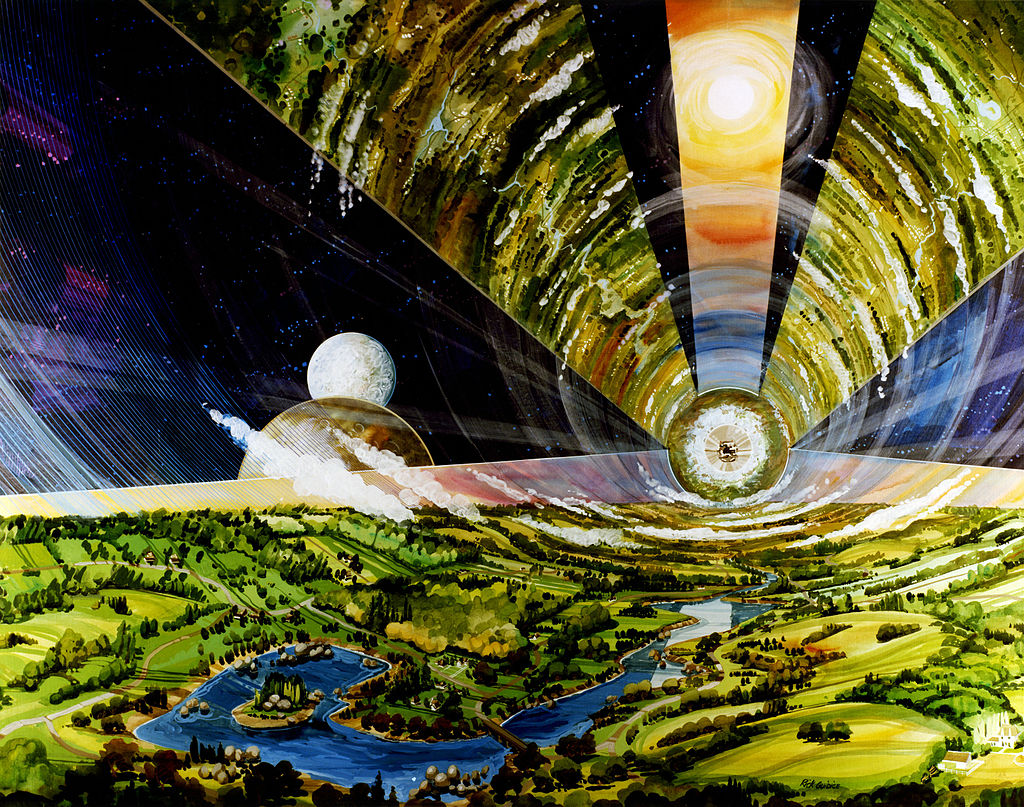
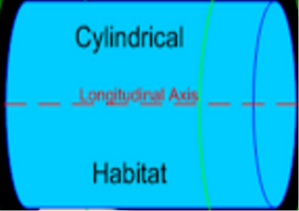 Habitat Hull. Sections could be manufactured on Lunar surface; then, launched into Lunar orbit for further assembly. As discussed in subsequent text, such modules could be ejected from Lunar orbit and inserted into Solar orbit at well planned times. Completed modules could even include an ample supply of water which will be needed for its long voyage from Lunar orbit to an eventual parking spot 1 Astronomical Unit (AU) away.
Habitat Hull. Sections could be manufactured on Lunar surface; then, launched into Lunar orbit for further assembly. As discussed in subsequent text, such modules could be ejected from Lunar orbit and inserted into Solar orbit at well planned times. Completed modules could even include an ample supply of water which will be needed for its long voyage from Lunar orbit to an eventual parking spot 1 Astronomical Unit (AU) away.
Earth's Soil for Terraformation. Some items will need transhipment as well as transformation. For example, the first human settlements on Luna will need a means of food production. Most effective agriculture will use Terran soil with the microbes which make possible the growth of Terran flora; thus, initial Lunar agriculture will need to import several tons of Terran soil to be kept in Lunar "greenhouses". Eventually, the "seed" soil from Earth will spread as carefully selected portions of Lunar material mix with it. In turn, portions of this "terraformed" Lunar soil will ship to the habitats to start their own agricultures.
Some items will need transhipment as well as transformation. For example, the first human settlements on Luna will need a means of food production. Most effective agriculture will use Terran soil with the microbes which make possible the growth of Terran flora; thus, initial Lunar agriculture will need to import several tons of Terran soil to be kept in Lunar "greenhouses". Eventually, the "seed" soil from Earth will spread as carefully selected portions of Lunar material mix with it. In turn, portions of this "terraformed" Lunar soil will ship to the habitats to start their own agricultures.
Perhaps Luna's most valuable resource is her position as an excellent launch platform. Thus, assume feasible methods to routinely, launch payloads from Lunar surface to Lunar orbit. Such methods might include:
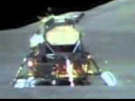 1. Traditional chemical, rocket launch (like the Apollo return missions).
1. Traditional chemical, rocket launch (like the Apollo return missions).
Recall that required rocket fuel components (oxygen and hydrogen) are plentiful on Lunar Surface.
2. Lunar Space Elevator.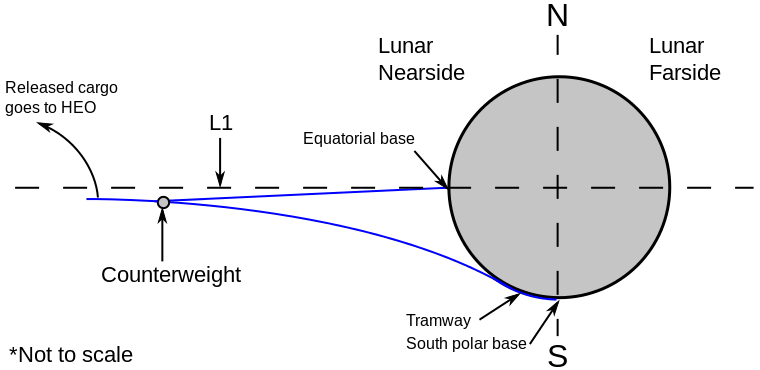 This concept is similar to the better known Earth-based space elevator idea; however, engineering requirements for constructing a lunar elevator system can be more easily met due to Luna's much lower gravity.
This concept is similar to the better known Earth-based space elevator idea; however, engineering requirements for constructing a lunar elevator system can be more easily met due to Luna's much lower gravity.
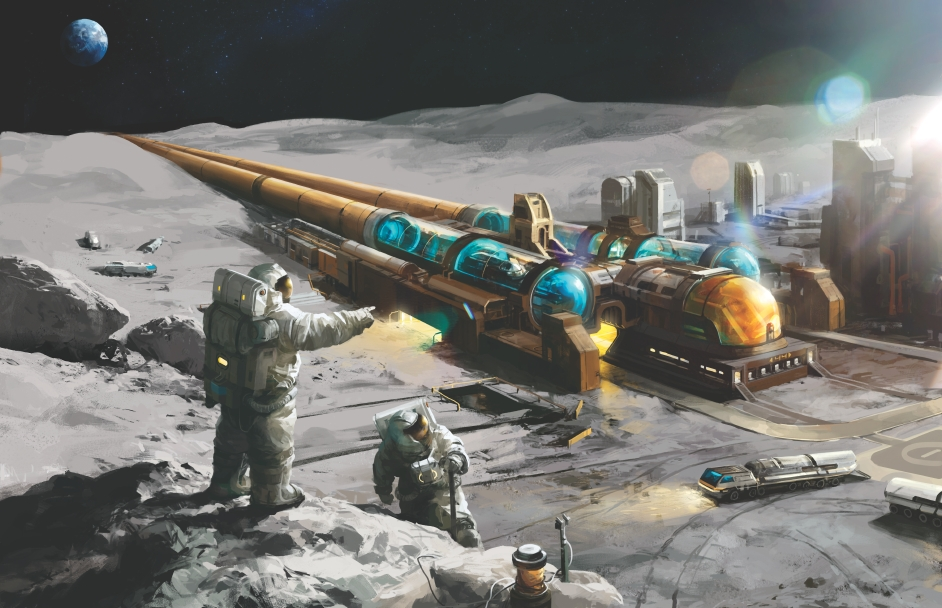 3. Lunar Mass Driver. Using magnetic levitation, this engine would accelerate a payload to the necessary speed (about 2.4 kps) required to escape the Moon's gravity and orbit Luna.
3. Lunar Mass Driver. Using magnetic levitation, this engine would accelerate a payload to the necessary speed (about 2.4 kps) required to escape the Moon's gravity and orbit Luna.
Orbiting around Luna, Habitat α must accomplish a carefully planned, well timed insertion into Solar Orbit. Consider the New Moon phase, Luna is directly between the Sun and the Earth. (Earth bound observers see a full view of the unlit portion of the moon. Every few years, some see a Solar Eclipse in the daytime when the New Moon is precisely between Sol and Earth.)
TE arbitrarily names point α the Earth-Sun Lagrange 4 (L-4) point, which leads Earth by 60° in the Terran orbit around Sol. TE proposes leveraging Luna to launch a habitat to get there.
This agrees with previous results from the Clementine mission.
Scientists estimate as much as 6 trillion kilograms of lunar ice.
Helium-3.
| HABITAT TRANSFORMATION |
|---|
Mirrors for Light.
Habitat’s critical requirement will be a source of energy. Since the habitat will stay very near the Terra-Sol orbit, there should be plenty of sunlight available.
 Habitat's exterior mirrors must perpetually collect solar energy to light up and energize the habitat's interior. Thus, one of the very first components to be shipped to these habitats would be a completed, large mirror suitable for reflecting light to desired locations on the habitat.
Habitat's exterior mirrors must perpetually collect solar energy to light up and energize the habitat's interior. Thus, one of the very first components to be shipped to these habitats would be a completed, large mirror suitable for reflecting light to desired locations on the habitat.
 Habitat's exterior mirrors must perpetually collect solar energy to light up and energize the habitat's interior. Thus, one of the very first components to be shipped to these habitats would be a completed, large mirror suitable for reflecting light to desired locations on the habitat.
Habitat's exterior mirrors must perpetually collect solar energy to light up and energize the habitat's interior. Thus, one of the very first components to be shipped to these habitats would be a completed, large mirror suitable for reflecting light to desired locations on the habitat.Earth's Soil for Terraformation.
| LUNAR LAUNCH |
|---|
Recall that required rocket fuel components (oxygen and hydrogen) are plentiful on Lunar Surface.
2. Lunar Space Elevator.
| ENTER SOLAR ORBIT |
|---|
| HABITAT ALPHA (Hab-α) |
|---|

New Moon.
New Moon is the lunar phase when Luna is directly between Sol and Terra. If Habitat Alpha (Hab-α) started a circular Solar orbit from the New Moon, the radius would be slightly smaller than Earth's (1 AU), and the Period would be slightly shorter than Earth's (1 year) with a slightly higher orbital velocity.
New Moon is the lunar phase when Luna is directly between Sol and Terra. If Habitat Alpha (Hab-α) started a circular Solar orbit from the New Moon, the radius would be slightly smaller than Earth's (1 AU), and the Period would be slightly shorter than Earth's (1 year) with a slightly higher orbital velocity.
Once free of gravity influences from Luna and Terra, this vehicle would "lead" Earth in its Solar Orbit and would continually increase this lead until nudged back into Earth's orbit, 1 AU from Sol. Thus, the Hab-α could eventually "park" in a permanent position 60° ahead of Earth.
 Mean Motion.
Mean Motion. Compute Hab-α's mean motion (n) by dividing circular orbit's circumference (either 360° or 2π radians) by Hab-α's orbital period in Earth days. If radius from Sol to object is less than radius to Earth (1 AU), then object's n will always exceed Mother Earth's n. This difference grows so that eventually (a matter of years), Hab-α's lead becomes 60o.
Vehicle's travel must be planned so that it rejoins Earth's orbit at precisely the desired position. In this case, target is the Sol-Terra L-4 point. Once there, Hab-α can leverage L4's inherent stability to maintain a constant 60° lead from Earth.
| COLLISION CONCERNS |
|---|
1. LAUNCH SIZE. For first few launches, minimize risk with small mass; thus, worst case scenario (launched mass actually impacts Earth) will cause minimal damage. As confidence increases, launched mass (for subsequent additions to habitat) can increase.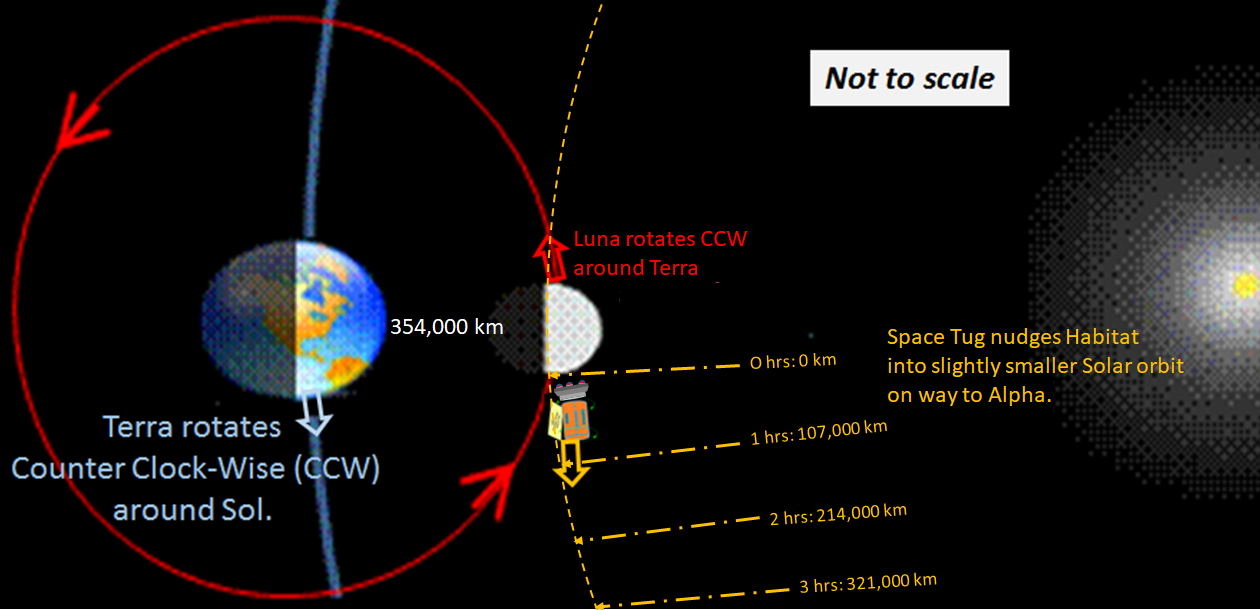 2. DANGER TO TERRA. Launch point will be from carefully chosen position on Luna at a carefully chosen position in Luna's orbit about Terra. This puts initial position of launched habitat at perhaps 354,000 km from Terra. If launch vectors put habitat into appropriate Solar orbit, habitat will escape the gravity pull of the Terra-Luna system.
2. DANGER TO TERRA. Launch point will be from carefully chosen position on Luna at a carefully chosen position in Luna's orbit about Terra. This puts initial position of launched habitat at perhaps 354,000 km from Terra. If launch vectors put habitat into appropriate Solar orbit, habitat will escape the gravity pull of the Terra-Luna system.
3. DANGER FROM LUNA. Will the moon impact our habitat on the next Lunar orbit? Assume space tug assures successful orbital insertion into slightly smaller Solar orbit. Following Alpha launch tables indicate that likely separation distances will prevent Lunar collisions.
3. DANGER FROM LUNA. Will the moon impact our habitat on the next Lunar orbit? Assume space tug assures successful orbital insertion into slightly smaller Solar orbit. Following Alpha launch tables indicate that likely separation distances will prevent Lunar collisions.
| ALPHA LAUNCH TABLES |
| After Lunar Launch, note continual increase of linear separation (distance, d) of habitat from Terra during first lunar cycle. |
 |
| Assume New Moon happens exactly when Terra crosses line from Sol to “Point of Aries” as shown. Further assume minimum Lunar radius (RL) of 354,000 km. If Hab-α carefully launches from Luna at New Moon phase, it achieves a Solar Orbit of 1 AU - RL . |
1 AU - RL = 149,597,870.7 km - 354,000 km
1 AU - RL = 1 AU - .00237 AU = 0.99763 AU
1 AU - RL = 1 AU - .00237 AU = 0.99763 AU
For convenience assume angular velocity of time × mean motion for both Terra and Hab-α.
Assume Habα Mean Motion: nα = 0.9902o/dy
Assume Earth Mean Motion: n♁ = 0.9867o/dy
Inset rectangle shows Hab-α progress during first Lunar Cycle (New Moon to New Moon), a duration of 29.5 days.
CONSIDER: Will Hab-α avoid Lunar collision during this critical first Lunar Cycle?
Inspection of most likely Hab-α progress indicates that such collision is unlikely. Immediate Lunar motion is distinctly away from Hab-α in its Solar Orbit; thus, collision is unlikely as long as Hab-α escapes Luna’s gravity.
RECONSIDER: Will Luna collide with Hab-α when it returns to New Moon position? EXAMPLE: Again, this is very unlikely. During Full Moon phase when Hab-α and Luna are on opposite sides of Terra (thus, safely far apart); Hab-α is over 400,000 km from Terra, very near the max lunar radius of 407,000 km from Earth’s center.
By the time Luna returns to New Moon position and thus near Hab-α ‘s Solar radius, Hab-α has already increased its distance from Terra to over 499,000 km, well out of Luna’s reach. Now, Hab-α must just await 40+ years until it reaches 60⁰ ahead of Terra, and it modifies its Solar Radius to exactly 1.0 AU to maintain that 60⁰ lead.
| SUBSEQUENT OPPORTUNITIES |
|---|
TRANSITION: In next chapter, Landing Omega ...., we discuss Lunar Launches from Lunar orbit to Solar orbit during subsequent months and years throughout the 40+ year duration from Lunar launch to Solar parking at 60° (a full AU) from Terra.
See also: Space colonies at Lagrange Points.

0 Comments:
Post a Comment
<< Home